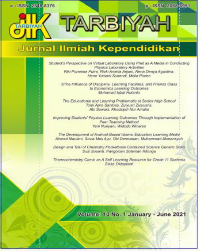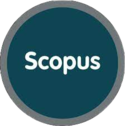Improving Students' Physics Learning Outcomes Through Implementation of Peer Teaching Method
DOI:
https://doi.org/10.18592/tarbiyah.v10i1.4165Abstract
Classroom action research using peer teaching methods to improve learning outcomes in physics subject circular motion. This study's subjects were students of class X MIPA 3 SMA Negeri 4 Cirebon, Cirebon City, West Java Province, totaling 32 students. The data collection technique is done by test and observation. The research process was carried out in two cycles, each cycle consisting of four stages, namely: (1) action planning, (2) action implementation, (3) observation and interpretation, and (4) analysis and reflection. Based on the research that has been done, it can be concluded that there is an increase in learning outcomes in physics subject of student circular motion through the use of the Peer Teaching method. Pre-cycle data with a class average of 60.94 with a percentage of 28.13% complete learning or 9 students out of 32 students. The first cycle increased to 72.19% or 17 students completed with an average student grade of 53.13%, but this score had not yet reached the KKM that had been agreed upon. The second cycle increased to 81.25%, or 26 students completed with an average student score of 84.84. Thus, the peer teaching method's application can improve learning outcomes in the Physics subject of circular motion so that it is feasible to be applied in SMA Negeri 4 CirebonReferences
Astra, I., Wahyuni, C., & Nasbey, H. (2015). Improvement of Learning Process and Learning Outcomes in Physics Learning by Using Collaborative Learning Model of Group Investigation at High School (Grade X, SMAN 14 Jakarta). Journal of Education and Practice, 6(11), 75-79. Retrieved from https://eric.ed.gov/?id=EJ1081730
Boudah, D. J. (2019). Conducting Educational Research:" Guide to Completing a Thesis, Dissertation, or Action Research Project". SAGE Publications, Incorporated. https://doi.org/10.4135/9781483349138.n1
Damon, W., & Phelps, E. (1989). Critical distinctions among three approaches to peer education. International journal of educational research, 13(1), 9-19. https://doi.org/10.1016/0883-0355(89)90013-x
Effendi, E. (2015). Hubungan persepsi siswa terhadap penerapan model pembelajaran kooperatif tipe teaching sebaya dengan prestasi belajar fisika. Jurnal Pendidikan Fisika, 3(2), 14-24. https://doi.org/10.24127/jpf.v3i2.232
Gasong, D. (2018). Belajar dan pembelajaran. Yogyakarta: Deepublish.
Gillies, R. M. (2016). Cooperative learning: Review of research and practice. Australian journal of teacher education, 41(3), 39-54. https://doi.org/10.4135/9781446213971.n7
Gunawan, I., Ulfatin, N., Sultoni, S., Sunandar, A., Kusumaningrum, D. E., & Triwiyanto, T. (2017). Pendampingan Penerapan Strategi Pembelajaran Inovatif dalam Implementasi Kurikulum 2013. Abdimas Pedagogi: Jurnal Ilmiah Pengabdian kepada Masyarakat, 1(1). 37-47. http://dx.doi.org/10.17977/um050v1i1p%25p
Hastuti, A., Sahidu, H., & Gunawan, G. (2017). Pengaruh Model PBL Berbantuan Media Virtual Tehadap Kemampuan Pemecahan Masalah Fisika. Jurnal Pendidikan Fisika dan Teknologi, 2(3), 129-135. https://doi.org/10.29303/jpft.v2i3.303
Irmawati, A., & Ashar, H. (2016). Penerapan Strategi Pembelajaran Teaching Sebaya Dalam Meningkatkan Hasil Belajar Kit Eksperimen Fisika. Jurnal Pendidikan Fisika, 4(2), 67-70.
Khasinah, S. (2013). Classroom action research. PIONIR: Jurnal Pendidikan, 4(1), 101-114.
Kurniawan, D. A., Perdana, R., & Kurniasari, D. (2018). Identification of student attitudes toward physics learning at Batanghari District high school. The Educational Review, USA, 2(9), 475-484. https://doi.org/10.26855/er.2018.09.003
Kusumah, M. I., & Septian, D. (2018). Pengaruh Metode Pembelajaran Teaching Sebaya (Peer Teaching) Terhadap Hasil Belajar Siswa Pada Mata Pelajaran Fisika Pokok Bahasan Vektor Kelas X MIPA MAN 1 Cirebon. Jurnal Pendidikan Fisika dan Sains (JPFS), 1(1), 33-39. Retrieved from http://journal.unucirebon.ac.id/index.php/jpfs/article/view/62
Ladyshewsky, R. K. (2006). Peer coaching: A constructivist methodology for enhancing critical thinking in postgraduate business education. Higher Education Research & Development, 25(1), 67-84. https://doi.org/10.1080/13600800500453196
Mettetal, G. (2002). Improving teaching through classroom action research. Essays on teaching excellence: Toward the best in the Academy, 14(7), 1-4.
Mettetal, G. (2002). The What, Why and How of Classroom Action Research. Journal of the Scholarship of Teaching and Learning, 2(1), 6-13. https://doi.org/10.4135/9781452220697
Misnoraliawati, M. (2018). Efektifitas Penggunaan Metode Teaching Sebaya Terhadap Hasil Belajar Fisika Siswa Kelas Xi IPA II MAN I Palembang. Jurnal Inovasi dan Pembelajaran Fisika, 5(1), 31-42. https://doi.org/10.36706/jipf.v5i1.5750
Nasihah, E. D., Supeno, S., & Lesmono, A. D. (2019). Model Problem Based Learning (PBL) Disertai Teaching Sebaya Untuk Meningkatkan Keterampilan Berpikir Kritis Siswa SMA. FKIP e-Proceeding, 3(2), 178-183. https://doi.org/10.24127/jpf.v8i1.1899
Putra, D. S., & Wiza, O. H. (2019). Analisis Sikap Siswa Terhadap Mata Pelajaran Fisika di SMA Ferdy Ferry Putra Kota Jambi. UPEJ Unnes Physics Education Journal, 8(3), 299-311. https://doi.org/10.15294/upej.v8i3.35631
Qudsi, F. T. (2014). Pembelajaran teaching sebaya materi besaran dan satuan fisika. Jurnal Pendidikan Tindakan Kelas, 4(1).1-10.Retrieved from http://i-rpp.com/index.php/dinamika/article/view/84
Romano, D. M., & Brna, P. (2001). Presence and reflection in training: Support for learning to improve quality decision-making skills under time limitations. CyberPsychology & Behavior, 4(2), 265-277. https://doi.org/10.1089/109493101300117947
Rubin, L., & Hebert, C. (1998). Model for active learning: Collaborative peer teaching. College Teaching, 46(1), 26-30. https://doi.org/10.1080/87567559809596229
Stigmar, M. (2016). Peer-to-peer teaching in higher education: A critical literature review. Mentoring & Teachinging: partnership in learning, 24(2), 124-136. https://doi.org/10.1080/13611267.2016.1178963
Suharsimi, A. (2010). Prosedur penelitian: suatu pendekatan praktik (edisi revisi). Jakarta: Rineka Cipta
Ulstad, S. O., Halvari, H., Sørebø, Ø., & Deci, E. L. (2016). Motivation, learning strategies, and performance in physical education at secondary school. Advances in Physical Education, 6(1), 27-41. https://doi.org/10.4236/ape.2016.61004
Winarso, W. (2018). Authentic assessment for academic performance: study on the attitudes, skills, and knowledge of grade 8 mathematics students. Malikussaleh Journal of Mathematics Learning (MJML), 1(1), 1-8. https://doi.org/10.29103/mjml.v1i1.579
Zenti, E. (2019). Peningkatan Aktivitas Belajar Peserta Didik melalui Model Pembelajaran Kooperatif dengan Metode Teaching Sebaya. Jurnal Kinerja Kependidikan (JKK), 1(1), 1-17. https://doi.org/10.29210/12017297
Zulfira, T. (2017). Pengaruh Metode Pembelajaran Collaborative Learning Dipadu Dengan Metode Teaching Sebaya Terhadap Hasil Belajar Fisika Siswa. Jurnal Ilmiah Mahasiswa Pendidikan Fisika, 2(1), 175-179. Retrieved from http://www.jim.unsyiah.ac.id/pendidikan-fisika/article/view/2229
Downloads
Published
How to Cite
Issue
Section
License
Authors retain copyright and grant the journal right of first publication with the work simultaneously licensed under a Creative Commons Attribution 4.0 International License that allows others to share the work with an acknowledgment of the work's authorship and initial publication in this journal.




